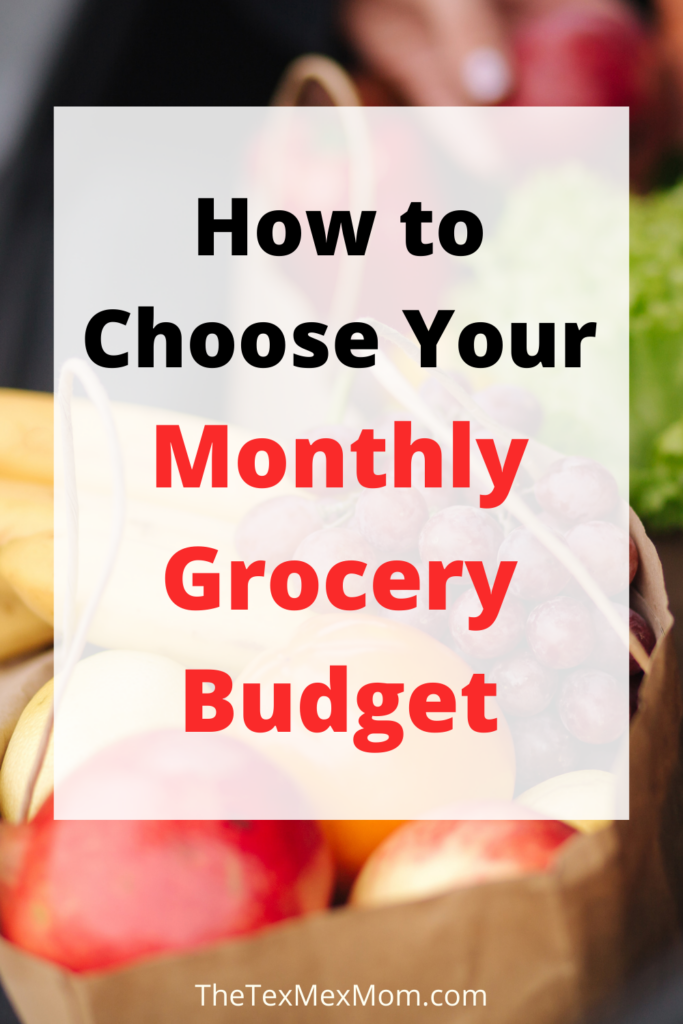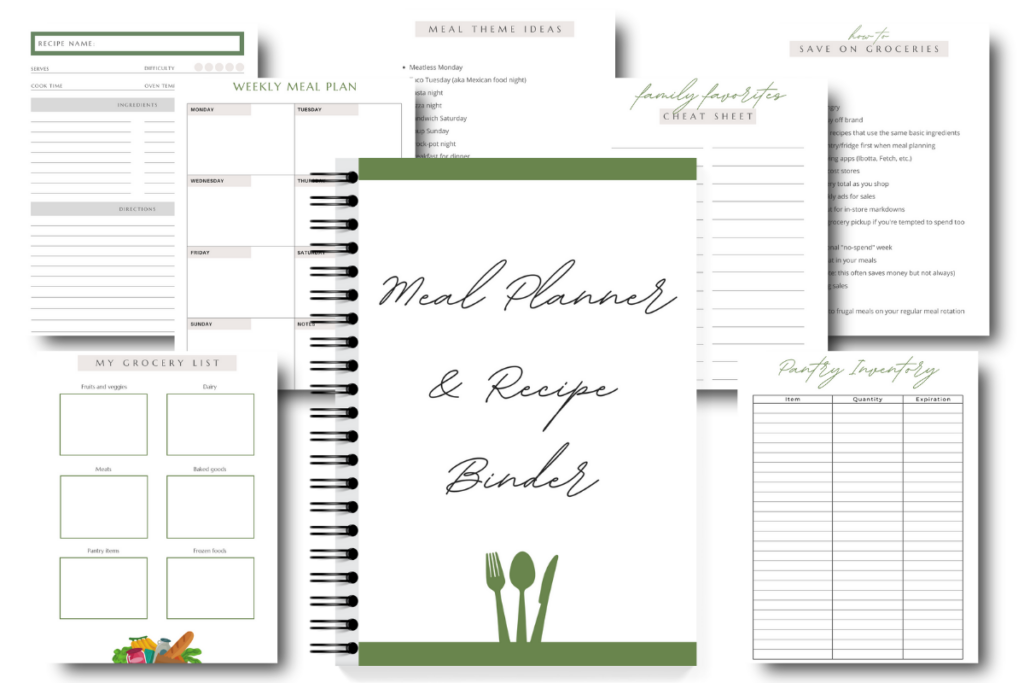Wondering how much you should be budgeting for groceries per month? Let’s talk about the factors you should consider and how to choose the grocery spending amount that’s best for you!

How much should I be budgeting for groceries per month? Am I spending way too much? What do most families my size spend?
We’re going to talk about all of these questions today and hopefully by the end of this article you’ll feel better equipped to make a solid plan for your monthly grocery spending.
Things to Consider Before Setting a Monthly Grocery Budget
There are multiple factors to consider as you attempt to answer the question How much money should I be budgeting for groceries per month? Let’s highlight a few of them!
Your family
What is your family size? Are you a single person? A married couple with one child? Empty nesters? A large family with a bunch of hungry teens? Your family size will obviously make a big difference in your average spending on groceries.
Your food needs and preferences
It’s important to consider your family’s needs as you work on determining a good monthly grocery budget. Do you or your family have food allergies that will factor into your budget? What about specific preferences like organic food or special whole foods? Do you enjoy restaurant meals on a regular basis or mostly eat at home?
Your location
Location plays a big part in the amount of your monthly grocery bill. For instance, don’t look up the average cost of food in Texas (where I live) if you live in the northwest because it’s most likely going to be different.
Your financial situation and goals
What is your financial situation? Are you wanting to cut your grocery spending a bit in order to save towards some financial goals? Or are you budgeting out of sheer necessity? Answering these questions will give you a better idea of how to budget.
Now that we’ve considered these factors, let’s talk a bit about average grocery spending.
A Look at National Averages for Food Spending
What is everyone else spending on food these days? We’ve probably all wondered what the average family’s food spending looks like, so let’s talk about it. Just keep in mind that every situation is different. While comparison can be helpful to give you an idea, it shouldn’t be the primary factor on which you base your budget.
The U.S. Department of Agriculture states that “in 2020, households in the lowest income quintile spent an average of $4,099 on food . . . while households in the highest income quintile spent an average of $12,245 on food.”
Breaking those numbers down monthly, that means that in 2020 U.S. households spent between $341 and $1020 per month on groceries. Of course, due to inflation and the rise in food costs recently I suspect that the average household is spending more now.
The USDA also gives recommended grocery spending numbers each month with four different plans: thrifty, low, moderate, and liberal food plans. The thrifty plan for April 2022 for a family of four is $916.70. That seems like a lot of money for the “thrifty” plan!
Finally, in an informal poll in a Facebook mom group, the majority of families of 5-6 said they typically spend between $700-900 a month on groceries, with a slightly smaller group estimating a bit less at $500-700 per month.
Setting Your Monthly Grocery Budget
We’ve talked about the different factors to consider before setting your grocery budget and we’ve looked at the national averages for food spending. Now it’s time to decide on your own monthly food budget!
So, how much should you spend on groceries per month?
Money Saving Mom suggests that a good starting point for figuring out your grocery budget is to allot $25 per person per week.
For a family of four, this would come out to a budget of $400 when there are four weeks in a month. For a family of six it would come out to $600. This is definitely less than many households are spending, but in my experience it’s totally doable.
Here’s my biggest suggestion though – if you start out too ambitious and set your monthly grocery budget too low you’ll feel like a failure when you go way over budget and you won’t want to keep trying.
So, choose an amount that you know is doable and make that your starting point. Then each month try to reduce your budget by a bit more until you feel like it’s in a good spot.

Tips for Cutting Back Your Monthly Grocery Budget
Reducing your grocery budget a bit each month sounds like a good idea, but is it doable? Here are a few ways to cut back:
1. Make a list
It’s always a good idea to make a grocery list. And once you’ve made your list, make sure to stick to it! You can grab my simple grocery list printable here.
2. Shop your pantry first
You don’t need to start from scratch for every grocery trip. Check your pantry, fridge, and freezer ahead of time to see what food items you already have on hand and go from there.
3. Buy off brand
Although I like to buy name brands for certain items, for most things the generic brand is comparable and cheaper! I’ve found that the store brands at Aldi in particular are always really good.
4. Use money-saver apps
Apps like Ibotta, Fetch and more are all great to use! While these apps won’t make you rich, they can definitely save you a few bucks here and there which can add up to a decent amount over the course of a year.
5. Shop at lower-cost grocery stores
Do you have any local discount stores? A grocery discount store can save you lots of money compared to a regular store. Other grocery stores to consider are ones with lower price points like Aldi, Winco, etc.
If you don’t have any lower-priced grocery stores nearby, Kroger or one of their affiliate stores are known to have great sales so be sure to check their ad every week!
The bottom line is that the easiest way to save money on groceries is to simply choose to shop at the least expensive grocery store in your area.
6. Stretch the meat in your meals
Unless you’re a vegetarian, meat is probably one of the pricier items on your grocery list each week. Learn to stretch it by having a meatless meal once a week, serving smaller portions of meat (while upping your healthy sides), mixing beans in with your taco meat, etc.
7. Stock up when there are sales
If you have a little wiggle room in your weekly grocery budget it’s a great idea to stock up when you see a good sale. It can definitely help you to save money on groceries down the road!
8. Choose simple recipes
When planning your meals for the week, don’t choose a bunch of recipes with exotic ingredients. Keep things simple and it’ll be much easier to save money on groceries.
9. Grocery shop just once a week (or less)
You know those weeks when you keep running back to the grocery store for random items you forgot? Well, that’s a great way to over spend on groceries! Make a thorough shopping list, grab everything you need the first time and then don’t go grocery shopping again for the rest of the week.
10. Have a no-spend week every so often
As un-exciting as this sounds, no-spend weeks will force you to be creative with what you have – and you’ll probably realize that you have more things on hand than you realized.
Helpful Resources
Here are some of my favorite resources to help you as you figure out your monthly grocery budget and work to improve your spending habits.
Free Meal Plans
Here on the blog I’ve shared multiple budget-friendly meal plans (along with grocery lists) to help you with your meal planning. You can check some of them out below:
- $50 One Week Meal Plan
- $60 One Week Meal Plan
- $65 One Week Meal Plan
- $75 One Week Meal Plan
- $80 One Week Meal Plan
- $100 Two Week Meal Plan
- $120 Two Week Meal Plan
- 5 Meals for $40
Slash Your Grocery Bill
Another great resource is this ebook from Crystal Paine at MoneySavingMom.com. It’s called Slash Your Grocery Bill and it shares 25 simple and effective ways to cut your grocery bill.
I found it very helpful and full of good tips beyond just the basic stuff. I’m an affiliate for Crystal’s products because they are always well done and worth what she charges (which I can’t truthfully say for a lot of ebooks and courses out there!)
If you’re interested you can check it out here!
Meal Planner and Recipe Binder
Finally, my new meal planner and recipe binder kit is a great resource if you’re trying to save money on food by meal planning and cooking at home on a more regular basis.

Meal planning is a great way to help you stick to the amount you’re budgeting for groceries per month. This Meal Planner and Recipe Binder is just what you need in order to have everything you need for meal planning: pantry inventory, grocery list, meal ideas, your most used recipes, and more – all in one spot. And right now it’s on sale for just $5!!
Check out the Meal Planner & Recipe Binder here!
So, how are you feeling? Do you have a better grasp now on how much you should be budgeting for groceries per month? Is there anything I missed that I should’ve mentioned in this article? Let’s chat in the comments!


